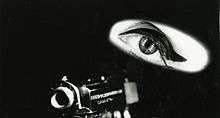Noir fiction

Noir fiction (or roman noir) is a literary genre closely related to hardboiled genre[1] with a distinction that the protagonist is not a detective, but instead either a victim, a suspect, or a perpetrator. Other common characteristics include the self-destructive qualities of the protagonist.[2] A typical protagonist of noir fiction is dealing with the legal, political or other system that is no less corrupt than the perpetrator by whom the protagonist is either victimized and/or has to victimize others on a daily basis, leading to lose-lose situation.
The origin of the term
The term originates as a cinematic one.[3] Film noir refers to cinematic works influenced by novels of the hardboiled tradition, exhibiting postwar disillusionment and realism as influenced by German Expressionism.[4] "Noir" was popularized as applied to fiction by editor Barry Gifford of the crime fiction publisher Black Lizard in the 1980s.
The genre's pioneers
James M. Cain – also regarded as the third major figure of the early hardboiled genre[5] – is regarded as an American pioneer of the noir genre. He debuted as a crime novelist in 1934. Other important American writers in the noir genre include Cornell Woolrich, Dorothy B. Hughes, Jim Thompson, David Goodis, Charles Williams, and Elmore Leonard.
Variants of noir
Mediterranean Noir

Mediterranean Noir refers to noir fiction in a Mediterranean setting. Sex, crime, and physical violence often figure prominently in Mediterranean Noir narratives. Social and historical issues specific to the region – particularly governmental corruption and instability, war, and racial strife – are frequently underlying plot considerations. Prominent authors of the movement include Jean-Claude Izzo, Andrea Camilleri, Massimo Carlotto, Eduardo Mendoza, Batya Gur and Enrico Teodorani.
According to the Italian publisher Sandro Ferri, Mediterranean Noir is remarkable for its attention to a unique duality of Mediterranean life:
The prevailing vision in the novels belonging to the genre known as Mediterranean noir is a pessimistic one. Authors and their literary inventions look upon the cities of the Mediterranean and see places that have been broken, battered, and distorted by crime. There is always a kind of dualism that pervades these works. On one hand, there is the Mediterranean lifestyle-- fine wine and fine food, friendship, conviviality, solidarity, blue skies and limpid seas-- an art of living brought almost to perfection. On the other hand, violence, corruption, greed, and abuses of power.
American Noir
W. R. Burnett, part of the first wave of hardboiled writers along with Hammett and Cain, wrote in a style that split the difference, often featuring heroic gangsters as his leads. The five novels featuring alcoholic detective Bill Crane written by Jonathan Latimer over the course of the 1930s constitute one of the earliest literary series of hardboiled screwball comedy. The work of Charles Willeford has sometimes been referred to as hardboiled or, particularly, noir fiction, though it is perhaps more helpfully characterized as "neo-noir," as Willeford's crime writing rarely employs the conventions of hardboiled literature without critiquing them.
Of latter-day hardboiled novelists who regularly feature detective protagonists, the most prominent to write in a noir mode is James Ellroy. In terms of character, plot, and worldview, Patricia Highsmith is a quintessential writer of noir fiction—indeed, her work has been the source for numerous movies, both American and European, regarded as films noir—but her style sets her apart: far from "lean" and "direct," it is characteristically dense and subtle.
Urban Noir
Not Country specific, Urban Noir focuses on the "underbelly" of life in a variety of cities, from London and Shanghai to Chicago and Boston. Johnny Temple, founder of Akashic Books (a noir publisher focusing on cities), cites a common urban noir thread as "authors whose life circumstances often place them in environs vulnerable to crime."[6] Akashic has published noir anthologies for over 50 cities and features short stories from some of the best known urban noir writers, including mainstream and crime/mystery writers known for occasional noir incursions, such as Don Winslow, Joyce Carol Oates, Michael Connelly, Dennis Lehane, Elmore Leonard and Lee Child.
See also
References
- ↑ William Marling (1998-10-01). The American Roman Noir: Hammett, Cain, and Chandler. ISBN 978-0-8203-2081-6.
- ↑ Tuttle, George (1997). "What Is Noir?". p. 1 of 2. Archived from the original on 2012-03-29. Retrieved 2011-08-25.
- ↑ Schrader, Paul (1971). "Notes on Film Noir". Filmex. Retrieved 2 June 2016.
- ↑ Mark Bould (2005-12-15). Film Noir: From Berlin to Sin City. Wallflower Press. p. 24. ISBN 978-1-904764-50-2.
- ↑ Abbot, p. 4
- ↑ Johnny Temple (2013). USA noir. Akashic Books. p. 11. ISBN 978-1-61775-184-4.
Further reading
- Paul Duncan (2000). Noir Fiction: Dark Highways. Pocket Essentials. ISBN 978-1-903047-11-8.
- Michelle Emanuel (2006). From Surrealism to Less-Exquisite Cadavers: Léo Malet and the Evolution of the French Roman Noir. Rodopi Bv Editions. ISBN 978-90-420-2080-1.
- Claire Gorrara (2003). The Roman Noir in Post-War French Culture: Dark Fictions. Oxford University Press on Demand. ISBN 978-0-19-924609-0.
- Gorrara, Claire, "French Crime Fiction: From Genre Mineur To Patrimoine Culturel", in French Studies, 2007, Vol. LXI: pp. 209 – 214
- Gorrara, Claire, "Narratives of Protest and the Roman Noir in Post-1968 France", in French Studies, 2000, Vol. LIV: pp. 313 – 325
- John T. Irwin (2006). Unless the Threat of Death Is Behind Them: Hard-Boiled Fiction and Film Noir. JHU Press. ISBN 978-0-8018-8435-1.
- Oliver, Brian (January 30, 2005). "I'm not interested in the good guys winning". The Guardian.
- Reynolds, Michael (2006). "Black and Blue: An Introduction to the Mediterranean Noir Novel". Europa Editions.
- Kletter, Dana (April 26, 2006). "Med Noir". The Boston Phoenix.
External links
- "Noir Fiction" essay on the history of the style, including a selected and annotated list of significant works, by George Tuttle
- FIRN Annual Festival of Noir Fiction held in Frontignan, France.
- Europa Editions staff, Sandro Ferri
- Europa Editions press room, Massimo Carlotto
- List of "Ten Essential Neo-Noir Authors," by Richard Thomas at Flavorwire